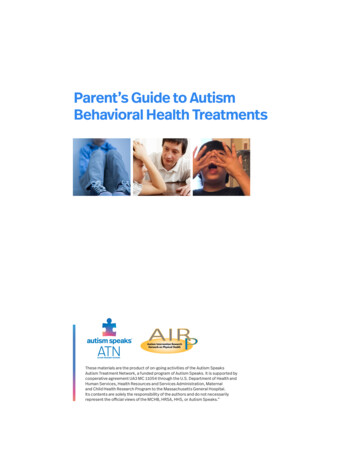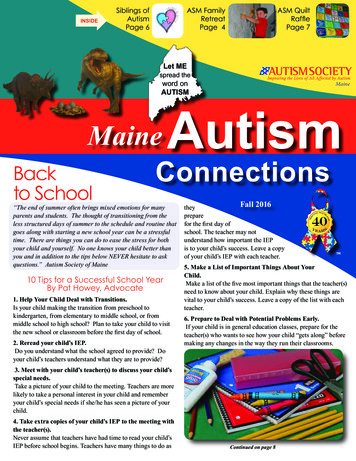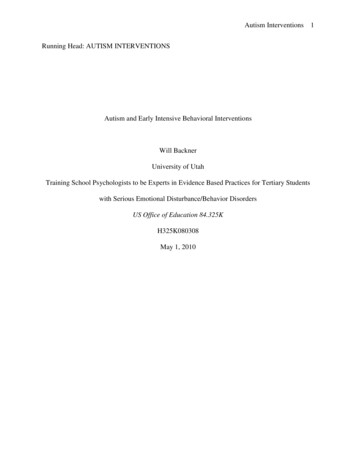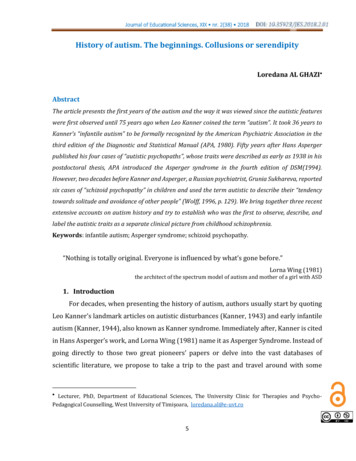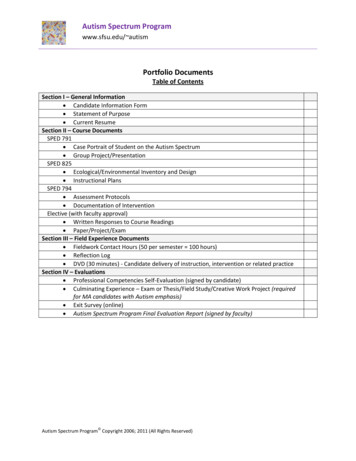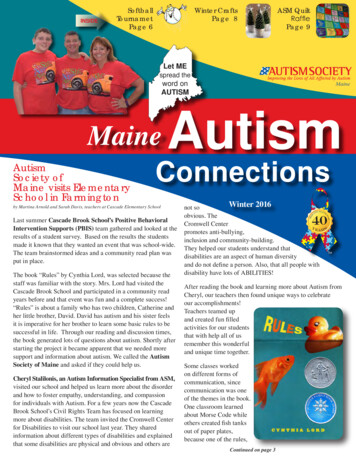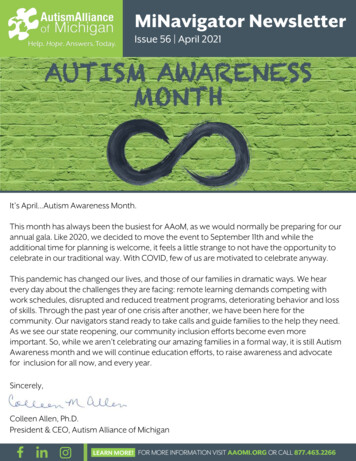
Transcription
Therapies for Children WithAutism Spectrum DisorderA Review of the Research for Parents and Caregivers
Is This Guide Right for the Child in My Care?Yes, if:The child you care for is 0 to 12 years old and has autism spectrumdisorder (ASD).No, if:The child you care for is older than 12 years or has a differentbehavioral, emotional, developmental, or learning disorder.What does this guide cover?This guide describes research about the possible benefits andnegative side effects of therapies for children who are 0 to 12years old and have ASD. It was created to help you talk with yourdoctor, school administrator, social worker, or health insurancerepresentative about programs and therapies.Where does the information in this guide come from?The information for this guide comes from a review of more than200 studies by an independent research center. The Agency forHealthcare Research and Quality, a Federal government agency,funded this report. The report was reviewed by doctors, patients,and other researchers. You can read the full report atwww.effectivehealthcare.ahrq.gov/autism1.cfm.
Understanding Your Child’s ConditionWhat is autism spectrum disorder (ASD)?ASD includes a range of behavioral symptoms.The two core features of ASD are: Difficulty with social interactions andcommunication. Repetitive behaviors, interests, andactivities.How common is ASD?About one in every 68 children in theUnited States has ASD. It is about fourtimes more common in boys thangirls. It can affect children of allraces and social classes whereverthey live. Researchers are not surewhat causes ASD.No two children with ASDare alikeASD is called a “widespectrum disorder” becausethe symptoms are differentfor each child. Symptoms canrange from mild to severe, andcan change as the child grows. Notwo children with ASD are alike.This makes understanding ASDand finding the best therapiesdifficult.1
Understanding Your OptionsHow do I make sense of all the different treatments?Treatments for ASD can be grouped into different categories (seefigure below). Each category focuses on a type of treatment.BehaviorProgramsMedicationsEducationand LearningProgramsOtherTreatmentsand TherapiesBecause children with ASD may show different symptoms, a familywill need to choose from the available treatments, therapies, andprograms based on their child’s needs. The treatment plan for yourchild may have some treatments from each of these categories.What can the research tell me?There is a lot of research being done on how to treat the symptomsof ASD in children or to help children overcome the challengesof ASD. But to decide whether something helps or not (or worksbetter than something else), researchers need to look at the resultsfrom many studies rather than just one. One study may find thatsomething helped, while another study may find that it did not.The information in this section will tell you about each type oftreatment and what researchers found when they looked at all thestudies at once.2
3
Behavior programsThese programs address social skills,attention, sleep, play, anxiety, parentinteraction, and challenging behaviors. Someprograms also help with children’s overalldevelopment.Many of these programs use specially trainedproviders who work with parents and children for up to 25 hoursevery week. The programs can last as long as 12 weeks to 3 years.They are held in homes, schools, and clinics.Early intensive behavioral intervention, cognitive behavioraltherapy, and social skills training are types of behavior programs.Early intensive behavioral interventions target children’s overalldevelopment. Programs such as the Lovaas Model and Early StartDenver Model mostly focus on working with children. Otherprograms, such as Pivotal Response Training and Hanen MoreThan Words, focus on teaching parents how to help their children.Programs that use cognitive behavioral therapy help childrenmanage anxiety. Coping Cat and Facing Your Fears are examples ofthis type of program.Social skills programs address social skills, attention, and play.Programs such as Skillstreaming help older children with theirsocial skills. Programs such as Joint Attention Symbolic PlayEngagement and Regulation (JASPER) aim to help youngerchildren with issues such as trouble with cooperative play.The behavior programs in your area may be based on these orother models. However, they might be called by different names.4
Do they help? Early intensive behavioral interventions that focus on helpingchildren with their overall development may improve a youngchild’s reasoning and communication skills. Research is not clearabout whether they improve social skills, daily living skills, orthe severity of ASD symptoms. Programs that focus on teaching parents how to help theirchildren show promise, but researchers do not yet know if theywork. Cognitive behavioral therapy reduces anxiety in some olderchildren with ASD who do not have other developmental delaysand have average reasoning and language skills. Social skills programs may help school-age children withoutother developmental or language delays for short periodsof time. More research is needed to know whether childrenremember and use these skills after the programs end. Programs that address how children play may improve children’ssocial interactions, but more research is needed to know forsure.What are the costs?The costs of behavior programs vary by State. Providers havedifferent fees. Insurance may not cover some costs. You shouldcheck with your insurance plan to find out about coverage. Otherassistance may be available. Ask your doctor.What else should I think about?Because of the amount of time involved, you may need to changeyour family’s schedule or routine to participate in some programs.5
6
Education and learning programsThese programs are offered in schools or otherlearning centers. They focus on learning andreasoning skills and “whole life” approaches.Schools may have different names for theirprograms, but many of these programs arebased on the Treatment and Education ofAutistic and Communication related handicapped CHildren(TEACCH) approach. Programs like TEACCH use visual tools andarrange the classroom in ways that are easier to manage for a childwith ASD. Other programs are classroom- or center-based and use“applied behavior analysis” (commonly known as ABA) strategieslike positive reinforcement.Do they help? Some children in the TEACCH program showed improvementin motor skills (the ability to walk, run, hold items, or sit upstraight), eye-hand coordination, and thinking and reasoning.There were not enough studies for researchers to say for sure,however, whether TEACCH was effective. Other education programs have not been studied enough toknow if they work.What are the costs?Usually, these services are included in the cost of the school orlearning center, so there may not be any other costs to you if youare a resident of the school district or community.What else should I think about?Your school district or learning center may have other names forthese educational approaches, so you may want to ask about theexact types of strategies they use. Schools or other public agenciesmay be able to help pay for these programs if there are costs.7
MedicationsWhat medicines are used to treatASD symptoms? Antipsychotics:Risperidone (brand name: Risperdal ).Aripiprazole (brand name: Abilify ). Serotonin-reuptake inhibitors or “SRIs” (antidepressants).Examples include Prozac, Sarafem, Celexa, and Cipramil. Stimulants and other hyperactivity medicines.Examples include Ritalin, Adderall, and Tenex. Secretin. This medicine is used for digestion problems but someresearchers thought it might help children with ASD symptoms aswell. Chelation. This therapy uses substances to remove heavy metalsfrom the body, which some people think causes autism.Do they help? Research found that two antipsychotic drugs – risperidone(Risperdal ) and aripiprazole (Abilify ) – can help reduceemotional distress, aggression, hyperactivity, and self-injury.Many people who take risperidone and aripiprazole report sideeffects such as weight gain, sleepiness, tremors, and abnormalmovements. Because of these side effects, these medicines maybe best only for children who have more severe symptomsor have symptoms that might increase their risk of hurtingthemselves. SRIs and a hyperactivity medicine called methylphenidate(Ritalin ) have not been studied enough to know if they helptreat ASD symptoms. Research showed that secretin is not effective in improvingautistic symptoms.8
According to the U. S. Food and Drug Administration, there areserious safety issues associated with chelation products. Evenwhen used under the care of a doctor, these products can causeserious harm, including dehydration, kidney failure, and death.Research does not support the use of chelation for ASD.What are the costs?The cost to you for each type of medicine will depend on yourhealth insurance, the amount (dose) your child needs to take, andwhether a generic form of the medicine is available.9
Other treatments and therapiesYou may have heard or read of other types oftreatments or therapies that have been usedfor children with ASD, such as: Speech and language therapy. Music therapy. Occupational therapy. Acupuncture. Vitamins and mineral supplements. Massage therapy. The Picture Exchange Communication System. Responsive Prelinguistic Milieu Teaching. Neurofeedback. Sleep education and training.Do they help?These other therapies have not been studied enough to know ifthey help or have any side effects. This does not mean that they donot work or are not safe. It just means that researchers do not haveenough information to know for sure.What else should I think about?Because little is known about how well these treatments ortherapies work, talking about them with your doctor, other healthcare or education professionals, your family, and other people thatyou trust may help you decide whether to try them.10
Why is there so little known about ASD and thesetreatments?The research reviewed for this guide showed that some treatmentscan make specific improvements in the way a child thinks oracts. But researchers do not have enough information to knowwhether one type of treatment works better than any other. Formost treatments, researchers also do not know which treatmentswill work best for specific children. For example, research does notshow whether a program usually works best for older or youngerchildren, or for children with severe or less severe ASD.This does not mean that a treatment, therapy, or program will notbe helpful for your child. It only means that researchers do nothave enough information to say so with strong confidence.Researchers are still studying these treatments and therapies.Check with your doctor or a support group to find out about newresearch on the programs and treatments in this guide and aboutnew options.11
Making a DecisionThere are many things for you to consider when choosing therapiesor programs for your child. There are many people you should talkto, including your doctor, social worker, school administrator, andhealth insurance representative. Here are some questions to ask:What plan is best for my child?Do you think an early intensive intervention would help mychild? What other types of programs might be helpful? Do you think my child would benefit from taking medicine? What is available in my community?Are there any early intensive intervention programs in thiscommunity? Do the schools in this district have programs for children withASD? What support groups are available? What are the costs?How much will it cost for us to participate in these programs? Is help available from the schools or other public agencies? Does my health insurance plan cover any costs? What changes to our work schedules and life will weneed to make?How much time does each option take? What are ways that other families have fit these programs intotheir lives? What else can we do to help our child? 12
Which medicine, if any, is best for my child?What symptoms will the medicines help? How soon should I see changes in my child’s symptoms? What are the warning signs that my child may be having aharmful side effect? What else is available if my child needs different medicine? 13
SourceThe information in this guide comes from the reports,Comparative Effectiveness of Therapies for Children With AutismSpectrum Disorders and Therapies for Children With AutismSpectrum Disorder: Behavioral Interventions Update. The reportswere produced by the Vanderbilt Evidence-based Practice Centerwith funds from the Agency for Healthcare Research and Quality(AHRQ). For a copy of the reports, or for more information aboutAHRQ and the Effective Health Care Program, go s summary guide was prepared by the John M. EisenbergCenter for Clinical Decisions and Communications Science atBaylor College of Medicine, Houston, TX. It was reviewed byparents and caregivers of children with ASD. It was updated in2014 by researchers at AHRQ.AHRQ Pub. No. 14-EHC036-AReplaces AHRQ Pub. No. 11-EHC029-ASeptember 2014
Early intensive behavioral intervention, cognitive behavioral therapy, and social skills training are types of behavior programs. Early intensive behavioral interventions target children's overall development. Programs such as the Lovaas Model and Early Start Denver Model mostly focus on working with children. Other
